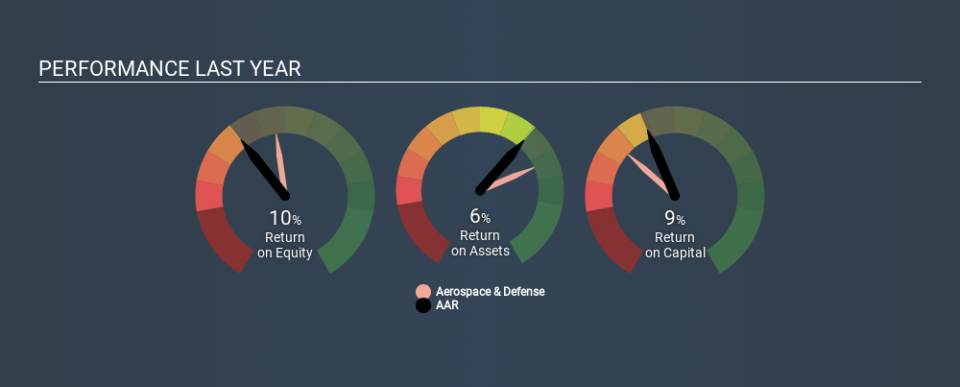Is AAR Corp.’s (NYSE:AIR) 9.3% Return On Capital Employed Good News?

Today we'll look at AAR Corp. (NYSE:AIR) and reflect on its potential as an investment. Specifically, we're going to calculate its Return On Capital Employed (ROCE), in the hopes of getting some insight into the business.
First, we'll go over how we calculate ROCE. Then we'll compare its ROCE to similar companies. And finally, we'll look at how its current liabilities are impacting its ROCE.
Return On Capital Employed (ROCE): What is it?
ROCE is a measure of a company's yearly pre-tax profit (its return), relative to the capital employed in the business. Generally speaking a higher ROCE is better. In brief, it is a useful tool, but it is not without drawbacks. Renowned investment researcher Michael Mauboussin has suggested that a high ROCE can indicate that 'one dollar invested in the company generates value of more than one dollar'.
How Do You Calculate Return On Capital Employed?
The formula for calculating the return on capital employed is:
Return on Capital Employed = Earnings Before Interest and Tax (EBIT) ÷ (Total Assets - Current Liabilities)
Or for AAR:
0.093 = US$125m ÷ (US$1.8b - US$407m) (Based on the trailing twelve months to November 2019.)
Therefore, AAR has an ROCE of 9.3%.
Check out our latest analysis for AAR
Is AAR's ROCE Good?
ROCE is commonly used for comparing the performance of similar businesses. Using our data, AAR's ROCE appears to be around the 11% average of the Aerospace & Defense industry. Setting aside the industry comparison for now, AAR's ROCE is mediocre in absolute terms, considering the risk of investing in stocks versus the safety of a bank account. Investors may wish to consider higher-performing investments.
In our analysis, AAR's ROCE appears to be 9.3%, compared to 3 years ago, when its ROCE was 6.2%. This makes us wonder if the company is improving. The image below shows how AAR's ROCE compares to its industry, and you can click it to see more detail on its past growth.
When considering ROCE, bear in mind that it reflects the past and does not necessarily predict the future. ROCE can be misleading for companies in cyclical industries, with returns looking impressive during the boom times, but very weak during the busts. ROCE is, after all, simply a snap shot of a single year. Future performance is what matters, and you can see analyst predictions in our free report on analyst forecasts for the company.
AAR's Current Liabilities And Their Impact On Its ROCE
Current liabilities are short term bills and invoices that need to be paid in 12 months or less. The ROCE equation subtracts current liabilities from capital employed, so a company with a lot of current liabilities appears to have less capital employed, and a higher ROCE than otherwise. To counteract this, we check if a company has high current liabilities, relative to its total assets.
AAR has total liabilities of US$407m and total assets of US$1.8b. Therefore its current liabilities are equivalent to approximately 23% of its total assets. This very reasonable level of current liabilities would not boost the ROCE by much.
What We Can Learn From AAR's ROCE
If AAR continues to earn an uninspiring ROCE, there may be better places to invest. You might be able to find a better investment than AAR. If you want a selection of possible winners, check out this free list of interesting companies that trade on a P/E below 20 (but have proven they can grow earnings).
If you like to buy stocks alongside management, then you might just love this free list of companies. (Hint: insiders have been buying them).
If you spot an error that warrants correction, please contact the editor at editorial-team@simplywallst.com. This article by Simply Wall St is general in nature. It does not constitute a recommendation to buy or sell any stock, and does not take account of your objectives, or your financial situation. Simply Wall St has no position in the stocks mentioned.
We aim to bring you long-term focused research analysis driven by fundamental data. Note that our analysis may not factor in the latest price-sensitive company announcements or qualitative material. Thank you for reading.

 Yahoo Finance
Yahoo Finance 
